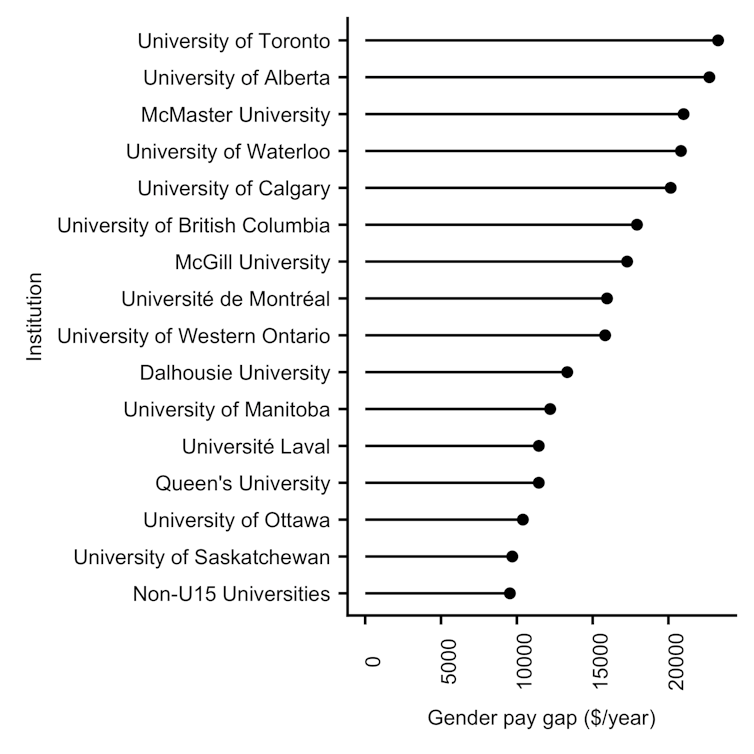
People participate in a Women’s March in Toronto in January 2018. (THE CANADIAN PRESS/Chris Young)
Megan Frederickson, Associate Professor of Ecology & Evolutionary Biology, University of Toronto
My sister and I are both professors. A few years ago, in the wake of the global financial crisis, she faced the possibility of a six per cent pay cut. She joked to me over the phone one night, “What am I going to do — have six per cent fewer thoughts?”
So naturally, when I learned that the University of Toronto pays female professors 14 per cent less than male professors, I wondered whether my employer thinks I have 14 per cent fewer thoughts.
I was researching the gender pay gap in order to lead an informal discussion in my department. We have a group that meets to crunch numbers on why there are so few female science professors. I ended up doing a deep dive into the publicly available data on professor salaries.

Gender pay gap at Canadian universities, measured as the difference in median salary between male and female professors. (Data from Statistics Canada for 2016-2017.)
Statistics Canada figures show that the University of Toronto paid male and female professors median salaries of $168,425 and $145,150, respectively, in 2016-2017. This is a difference of $23,275 a year, or 14 per cent. Over a 30-year career, this could add up to nearly $700,000 in lost income, a number that keeps me up at night.
The University of Toronto is not alone in paying female professors less. There is still a gender pay gap at nearly all Canadian universities, with especially big gaps at Canada’s 15 research-intensive universities, known as the U15.
Nationally, male professors were paid a median of $136,844 while female professors were paid $121,872 in 2016, a difference of $14,972, or 11 per cent.
Ever curious, I wanted to know why.
It’s not because men are better researchers
“Why?” is a data-hungry question.
Luckily, since 1996, Ontario’s “sunshine list” has published the salary of every professor in the province who earns more than $100,000 a year. This data set tends to underestimate the gender pay gap because it includes only professors making six-figure salaries, but it is rich in other ways. Salary data are available for more than 16,000 individual professors, in some cases going back 20 years.
Salary should reflect merit, but a professor’s merit is not easy to measure.
I know this first-hand from spending countless hours poring over professors’ CVs and research proposals for the Natural Sciences and Engineering Research Council of Canada (NSERC). I am on a committee tasked with boiling down a professor’s accomplishments to a single number: The dollar amount they will receive as a Discovery Grant.
The results are publicly available from NSERC, as are Insight Grant awards from the Social Sciences and Humanities Research Council of Canada (SSHRC), making it possible to combine grant and salary data for thousands of Ontario professors. These data sets do not include gender, but computer programs can infer gender from first names with high accuracy. (I used gender in the programming language R.)
Among all professors on the sunshine list, women were paid $9,921 less than men in 2016. Accounting for grant size hardly moves the needle, as women are paid close to this much less than men even when they get the exact same funding.
In other words, the gender pay gap is not because men bring in larger operating grants and therefore merit larger salaries. Also, the gender pay gap is slightly larger among professors getting grants from SSHRC than from NSERC, suggesting it is not driven by the scarcity of women in highly paid natural science or engineering fields.

Male professors are paid more than female professors even when they get the same grant funding. Each dot is an Ontario professor who held a Discovery (NSERC) or Insight (SSHRC) Grant in 2016. Lines are simple linear regressions. (Data from Ontario public salary disclosure and NSERC and SSHRC awards databases for 2016.)
The ghost of sexism past?
Some professors, mostly men, still working today were hired in the 1980s or even earlier. The gender pay gap at universities may be partly the legacy of gender bias in hiring that dates back several decades.
The highest paid professors are generally those who have worked at a university longest, so there may be few highly paid women now because universities hired very few women 30 years ago. However, the median male professor has been on Ontario’s sunshine list for only one year longer than the median female professor (seven versus six years, respectively).
Of course, I don’t know how long they were employed by a university before earning six figures. Still, the gender pay gap of today does not appear to be simply a holdover from discrimination of long ago.
My discussion group wanted to know more. What about race? The mommy penalty? Gender bias in tenure and promotion? Salary negotiation?
These are hard questions to answer with publicly available data, but universities can and should (and indeed sometimes do) study these factors with data collected by their human resources departments.
The gender pay gap is not a new problem. Ontario has legislated equal pay for equal work for over 30 years. It’s high time universities valued male and female professors equally.
This article was originally published on The Conversation. Read the original article.
![]()
The post Canadian professors still face a gender pay gap appeared first on Macleans.ca.


 Canadian National Occupational Classification
Canadian National Occupational Classification Pay Equity Commission
Pay Equity Commission US – Standard Occupational Classification
US – Standard Occupational Classification